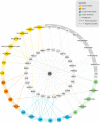Associations of Visceral Adipose Tissue, Circulating Protein Biomarkers, and Risk of Cardiovascular Diseases: A Mendelian Randomization Analysis
- PMID: 35186940
- PMCID: PMC8850399
- DOI: 10.3389/fcell.2022.840866
Associations of Visceral Adipose Tissue, Circulating Protein Biomarkers, and Risk of Cardiovascular Diseases: A Mendelian Randomization Analysis
Abstract
Aim: To evaluate the genetic associations of visceral adipose tissue (VAT) mass with metabolic risk factors and cardiovascular disease (CVD) endpoints and to construct a network analysis about the underlying mechanism using Mendelian randomization (MR) analysis. Methods and Results: Using summary statistics from genome-wide association studies (GWAS), we conducted the two-sample MR to assess the effects of VAT mass on 10 metabolic risk factors and 53 CVD endpoints. Genetically predicted VAT mass was associated with metabolic risk factors, including triglyceride (odds ratio, OR, 1.263 [95% confidence interval, CI, 1.203-1.326]), high-density lipoprotein cholesterol (OR, 0.719 [95% CI, 0.678-0.763]), type 2 diabetes (OR, 2.397 [95% CI, 1.965-2.923]), fasting glucose (OR, 1.079 [95% CI, 1.046-1.113]), fasting insulin (OR, 1.194 [95% CI, 1.16-1.229]), and insulin resistance (OR, 1.204 [95% CI, 1.16-1.25]). Genetically predicted VAT mass was associated with CVD endpoints, including atrial fibrillation (OR, 1.414 [95% CI, 1.332 = 1.5]), coronary artery disease (OR, 1.573 [95% CI, 1.439 = 1.72]), myocardial infarction (OR, 1.633 [95% CI, 1.484 =1.796]), heart failure (OR, 1.711 [95% CI, 1.599-1.832]), any stroke (OR, 1.29 [1.193-1.394]), ischemic stroke (OR, 1.292 [1.189-1.404]), large artery stroke (OR, 1.483 [1.206-1.823]), cardioembolic stroke (OR, 1.261 [1.096-1.452]), and intracranial aneurysm (OR, 1.475 [1.235-1.762]). In the FinnGen study, the relevance of VAT mass to coronary heart disease, stroke, cardiac arrhythmia, vascular diseases, hypertensive heart disease, and cardiac death was found. In network analysis to identify the underlying mechanism between VAT and CVDs, VAT mass was positively associated with 23 cardiovascular-related proteins (e.g., Leptin, Hepatocyte growth factor, interleukin-16), and inversely with 6 proteins (e.g., Galanin peptides, Endothelial cell-specific molecule 1). These proteins were further associated with 32 CVD outcomes. Conclusion: Mendelian randomization analysis has shown that VAT mass was associated with a wide range of CVD outcomes including coronary heart disease, cardiac arrhythmia, vascular diseases, and stroke. A few circulating proteins may be the mediators between VAT and CVDs.
Keywords: cardiovascular disease; mendelian randomization; obesity; two-sample MR; visceral adipose tissue.
Copyright © 2022 Huang, Liu, Ma, Tu, Liu, Bai, Xiao, Liu, Hu, Lin, Li, Ning, Zhou, Mao and Liu.
Conflict of interest statement
The authors declare that the research was conducted in the absence of any commercial or financial relationships that could be construed as a potential conflict of interest.
Figures




References
-
- Anaszewicz M., Wawrzeńczyk A., Czerniak B., Banaś W., Socha E., Lis K., et al. (2019). Leptin, Adiponectin, Tumor Necrosis Factor α, and Irisin Concentrations as Factors Linking Obesity with the Risk of Atrial Fibrillation Among Inpatients with Cardiovascular Diseases. Kardiol Pol. 77 (11), 1055–1061. 10.33963/kp.14989 - DOI - PubMed
LinkOut - more resources
Full Text Sources
Research Materials

